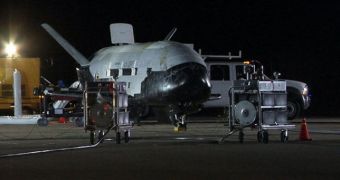The United States Air Force (USAF) is currently getting ready to launch its second unmanned spy space plane, following the successful landing of the first such spacecraft, about two months ago.
The X-37B autonomous space vehicle was originally developed by NASA, but then the project was handed over to the US Defense Advanced Research Projects Agency (DARPA) and the Pentagon.
Eventually, it ended up at the Air Force, which launched the first model on April 22, 2010. The spacecraft remained airborne until December 3, when it successfully landed at the Vandenberg Air Force Base (VAFB), in California.
During this flight, whose progress was kept under wraps, the USAF most likely collected critically-important data about all the systems aboard the space plane. Undoubtedly, the experience accumulated during the first X-37B flight will come in handy during the second.
The new space plane will launch aboard an Atlas 5 delivery system, from the Cape Canaveral Ar Force Station (CCAFS) Launch Complex 41. Take-off is scheduled for March 4, 2011, but the USAF did not provide an official time of launch.
These announcements were made by X-37B program manager Lt. Col. Troy Giese, who holds an appointment with the Air Force Rapid Capabilities Office, Space reports. The official declined to respond to questions seeking to determine the payload the new mission will carry
Giese explained in an email that the second Orbital Test Vehicle (OTV-2) has already been delivered to Florida, and that it's currently undergoing functional testing ahead of its planned mating with the Atlas 5 rocket. This maneuver is currently scheduled to take place in late February.
The two space planes the USAF ordered thus far were constructed at a facility in southern California, by main contractor and developer Boeing Phantom Works. At this point, both spacecraft have been delivered.
X-37B is a rather straightforward design. The spacecraft features a payload bay and a number of solar panels, which enables it to perform studies or surveillance-type observations from space, while at the same time exhibiting a great deal of autonomy.
The first mission lasted for about 225 days, but OTV-2 will most likely be kept in space for a lot more time. Additionally, its wheel tires got a special treatment from the OTV-1. When the first X-37B landed, one of its tires blew up, so now engineers are reducing pressure in the new ones by 15 percent.
“The Air Force remains extremely pleased with the performance of OTV 1. The quick-look review of OTV 1 re-entry and landing data and exterior inspection revealed no significant changes required for OTV 2,” Giese said.
“The Air Force will perform a detailed inspection and analysis as part of the refurbishment of OTV 1,” he concludes.

 14 DAY TRIAL //
14 DAY TRIAL //